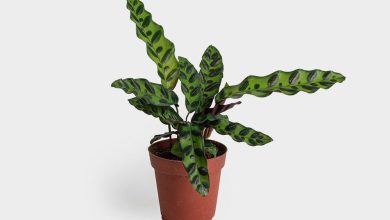Caring for ceropegia sandersonii


It is one of the most unique succulent plants that exist and, at the same time, a great unknown. The ceropegia sandersonii is one of those rarities of nature that is worth knowing up close. And it is that its flowering is, without a doubt, something exceptional and the reason why this plant receives such curious nicknames. In addition to being called the parachute plant, ceropegia sandersonii is also known as the parasol flower. Just look at it to understand where these unique nicknames come from.
But it is not the only singularity of the flower of the ceropegia sandersonii. Its flowering, which occurs between the end of summer and winter, is surprising for two reasons. On the one hand, because its size is incredibly large in proportion to the leaves. We are talking about the fact that, in an adult plant, the flower can be up to 10 centimeters wide. But even more surprising than its size is its shape. The flower of ceropegia sandersonii has five petals and a tubular shape, and its colors only make it even more unique.
But it is not the only anecdote about them, since they have a unique behavior. Like some orchids, this plant tends to trap insects inside its flowers. A behavior that could remind us of carnivorous plants, but that actually has a very different objective. The intention is, only, to be pollinated. And once the insect has fulfilled its mission, the flower releases it.
Discover this wonderful rarity of nature!
HOW TO GROW CEROPEGIA SANDERSONII
Understanding how to care for ceropegia sandersonii requires knowing a little more about it. And the starting point is knowing that it comes from South Africa and Mozambique. Some countries that mark, to a large extent, their temperature needs and in which the plant grows in the wild. In its natural state, ceropegia sandersonii forms part of the landscape and adapts to it. We say this because, although it is a climbing plant, if it does not find a support to do so, it will have a hanging habit.

And, even though this young plant is small in size, let’s not fool ourselves. The ceropegia sandersonii can reach two meters. Of course: having that length will take between five and 10 years. A time that gives us the clue: it is not a fast-growing plant. However, it is perfect for patient gardeners who want to enjoy a plant that is as rare as it is beautiful.
Beyond this, it is interesting to know that their care does not differ greatly from the care of succulents. And it is that it is a plant that is cataloged like this because its leaves are fleshy. Some in the shape of a heart, with a perennial character and that are capable of storing water.
Let’s see what the ceropegia sandersonii needs to show off its unique flowering.
1. Lots of light, one of the main cares for ceropegia sandersonii
From its origins, it is easy to guess that we are talking about a plant that needs a lot of light. A concept that we cannot confuse with direct sun exposure, especially in the summer months. If we have it in such a location, the only thing we will achieve is to damage the plant since it is sensitive to the sun’s rays.
Hence, the ideal is to place our ceropegia sandersonii in a space with a lot of light but, if possible, it should be early in the morning or late in the afternoon.

2. Good temperature, key to its development
It is an African plant and, as such, demands warm temperatures. The ideal is to have it between 20 and 28 degrees on a regular basis. But more than with the heat, we have to closely monitor the cold. We are talking about a plant that does not tolerate it, and that begins to compromise its well-being below 10 degrees.
3. Well aerated and better drained substrate, fundamental
As with all succulents, ceropegia sandersonii demands a soil rich in organic matter but with good aeration. And not only that: it is also demanding when it comes to drainage, since any excess moisture can rot its roots.

For this reason and for it to grow properly, the ideal is to opt for a cactus substrate that contains both the organic matter it needs and the percentage of sand that helps to drain.
4. Water maintaining the humidity of the substrate, one of the most important care for ceropegia sandersonii
If we know how to water succulents correctly, we will have to slightly vary the guideline in this case. Ceropegia sandersonii prefers that its substrate does not dry out completely, especially in the summer months. Let’s not confuse this with flooding since, as we said, its roots are extremely sensitive to excess water. And no: it is not a good idea to leave the excess irrigation water in the bottom plate of the pot. The ideal is that we remove it to avoid any unpleasantness.
The flowering months are the most demanding in terms of irrigation. However, in the winter months we can space it without problems.
5. Fertilize from the spring, an important help for its flowering
After the winter, the ceropegia sandersonii will wake up from its vegetative lethargy. It is precisely at this time that you will need a dose of regular fertilizer, with a guideline of once a month until the arrival of autumn.

It is important that we opt for a fertilizer for cacti and succulents, since the demand for fertilizer for this plant forces us to opt for a low-nitrogen formula. It will be enough to dilute it in the irrigation water so that it fulfills its function.
And yes: as you have seen, the care of ceropegia sandersonii is extremely simple. And also: to have it is to be able to contemplate a rarity of nature as striking as it is singular. You dare?

![Photo of Blackberry Pests and Diseases: [Detection, Causes and Solutions]](https://www.complete-gardening.com/wp-content/uploads/2022/08/blackberry-pests-and-diseases-detection-causes-and-solutions-390x220.jpg)

![Photo of Clavelina Cuttings: [Concept, Period, Rooting and Planting]](https://www.complete-gardening.com/wp-content/uploads/2022/08/clavelina-cuttings-concept-period-rooting-and-planting-390x220.png)
